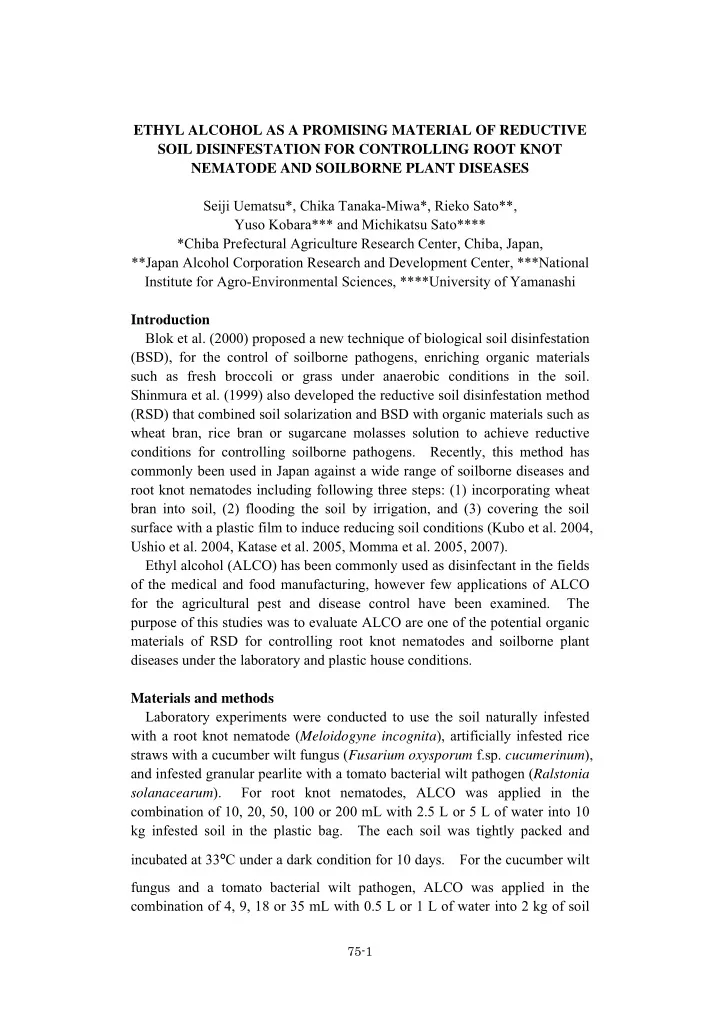

ETHYL ALCOHOL AS A PROMISING MATERIAL OF REDUCTIVE SOIL DISINFESTATION FOR CONTROLLING ROOT KNOT NEMATODE AND SOILBORNE PLANT DISEASES Seiji Uematsu*, Chika Tanaka-Miwa*, Rieko Sato**, Yuso Kobara*** and Michikatsu Sato**** *Chiba Prefectural Agriculture Research Center, Chiba, Japan, **Japan Alcohol Corporation Research and Development Center, ***National Institute for Agro-Environmental Sciences, ****University of Yamanashi Introduction Blok et al. (2000) proposed a new technique of biological soil disinfestation (BSD), for the control of soilborne pathogens, enriching organic materials such as fresh broccoli or grass under anaerobic conditions in the soil. Shinmura et al. (1999) also developed the reductive soil disinfestation method (RSD) that combined soil solarization and BSD with organic materials such as wheat bran, rice bran or sugarcane molasses solution to achieve reductive conditions for controlling soilborne pathogens. Recently, this method has commonly been used in Japan against a wide range of soilborne diseases and root knot nematodes including following three steps: (1) incorporating wheat bran into soil, (2) flooding the soil by irrigation, and (3) covering the soil surface with a plastic film to induce reducing soil conditions (Kubo et al. 2004, Ushio et al. 2004, Katase et al. 2005, Momma et al. 2005, 2007). Ethyl alcohol (ALCO) has been commonly used as disinfectant in the fields of the medical and food manufacturing, however few applications of ALCO for the agricultural pest and disease control have been examined. The purpose of this studies was to evaluate ALCO are one of the potential organic materials of RSD for controlling root knot nematodes and soilborne plant diseases under the laboratory and plastic house conditions. Materials and methods Laboratory experiments were conducted to use the soil naturally infested with a root knot nematode ( Meloidogyne incognita ), artificially infested rice straws with a cucumber wilt fungus ( Fusarium oxysporum f.sp. cucumerinum ), and infested granular pearlite with a tomato bacterial wilt pathogen ( Ralstonia solanacearum ). For root knot nematodes, ALCO was applied in the combination of 10, 20, 50, 100 or 200 mL with 2.5 L or 5 L of water into 10 kg infested soil in the plastic bag. The each soil was tightly packed and incubated at 33 º C under a dark condition for 10 days. For the cucumber wilt fungus and a tomato bacterial wilt pathogen, ALCO was applied in the combination of 4, 9, 18 or 35 mL with 0.5 L or 1 L of water into 2 kg of soil 75-1
in the plastic bag, respectively. Pathogens in the tea bags were buried in the soil. The each soil was tightly packed and incubated at 35 º C under dark conditions for 21 days. Plastic house experiments were conducted in the plastic houses naturally infested with M. incognita , and a spinach wilt fungus ( F. o. f. sp. s pinaciae ), respectively. ALCO was applied in the combination of 0.25 10, 20, 50, 100 or 1.5 mL/m 2 with 100 L/m 2 of water into the infested soil and the soil was flooded by irrigation in 4th Sept. 2006 in the experiment of M. incognita and 7th Sept. 2006 in the spinach wilt fungus. Soil was gently puddled and the soil surface was covered with a plastic film for 3 weeks. After the treatment, for evaluating the survival of M. incognita and the spinach wilt fungus, seedlings of cucumber were planted and spinach were sown in the treated plots in the plastic houses, respectively. Results Laboratory experiments: Second-stage larvae of the root knot nematode did not detected by the Baermann funnel technique in treatments with more than 5 mL of ALCO and 500 mL of water per kg of soil. F. o. f. sp. cucumerinum also was not detected in treatments with more than 9 mL of ALCO and 500 mL of water per kg of soil, and R. solanacearum was not detected in the treatment with 17.5 mL of ALCO and 500 mL of water per kg of soil from recovery tests with selected media. Plastic house experiment: Remarkable suppression effects for the root knot nematode and the spinach wilt were observed in the treatments of more than 0.5 kL of ALCO and 100 kL of water per 10a from the stand point of root knot severity (Table 1). In conclusion, ethyl alcohol seems a promising material of RSD for controlling root knot nematodes and soil borne plant diseases to promote a recycling society with a low impact to the environment, although, import price of ethyl alcohol are about $ 520 ( ≈ ¥60,000)/kL now in Japan. Further studies needed under more practical conditions to establish the RSD treatment technology. 75-2
Table 1. Effect of reductive soil disinfestation with ethyl alcohol on the root knot Root knot severity 1 Control effect value 2 Amount of treatment % of root knot observed Ethyl alcohol 3 (kL/10a) 0 86.1 27.1 65.8 0.25 58.3 18.8 76.3 25.0 6.3 92.1 0.5 1 2.8 0.7 99.1 1.5 0.0 0.0 100.0 Wheat bran 3 1 t/10a 85.7 21.4 72.9 0.0 0.0 100.0 Soilean 40 L/10a Non-treated 100.0 79.2 0.0 1 Culcurated from 100* ∑ (root knot index from 0 to 4*number of the pants of knotted root)/(4*number of the total plants examind). 2 Culcurated from 100*root knot severity/those of non-treated. 3 100 kL of water were applied. 75-3
Recommend
More recommend